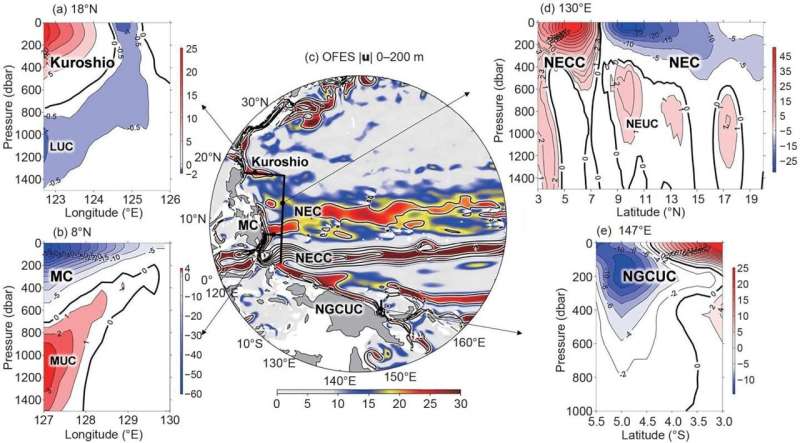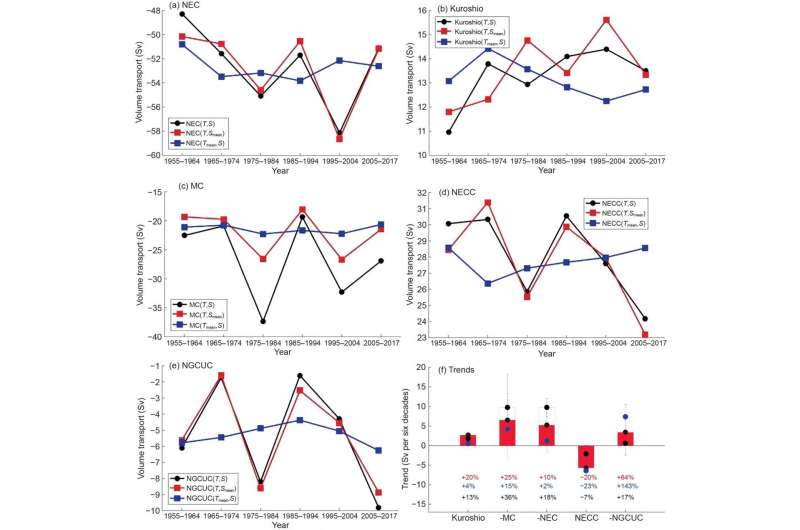Observations indicate strengthening of tropical Pacific western boundary currents for six decades

Against the background of global warming, the energy budget of the earth is out of balance with more than 90% of additional heat entering the ocean.
The tropical Pacific Ocean has an important influence on the global tropical climate and the climate of China, and the tropical Pacific Western Boundary Currents (WBCs) that flow through it play an important role in the climate system. Large-scale ocean circulation redistributes ocean heat and mass and is hence one of the basic dynamic processes that shape the earth's marine environment. The tropical Pacific WBCs system is a key part of the global ocean circulation system. Accurate assessment of the variation of the tropical Pacific WBCs is of much significance for better understanding of the variability of the Earth's climate system.
Recent study has shown that under the background of global warming, the global mean ocean circulation has significantly accelerated over the past 20 years, and this acceleration process is mainly in the global tropical waters. However, it is not clear whether the tropical Pacific WBCs will strengthen or weaken in the context of global warming, and the key to answering this question lies in ocean observations.
Recently, an article titled "Multi-decadal trends in the tropical Pacific western boundary currents retrieved from historical hydrological observations" was published in the Science China Earth Sciences. The research team led by Professor Shijian Hu, who is the first author from Institute of Oceanology, Chinese Academy of Sciences, evaluated the multi-decadal trends in the tropical Pacific WBCs using historical hydrological observations collected in the past over 60 years.

Hu's team focused on the tropical Pacific region and calculated the geostrophic components of the North Equatorial Current (NEC), North Equatorial Countercurrent (NECC), Mindanao Current (MC), Kuroshio in the origin and the New Guinea Coastal Undercurrent (NGCUC) using decadal mean hydrological observations from the World Ocean Atlas 2018 (WOA18), which is available from 1955 to 2017. Volume transports of the WBCs and their multi-decadal trends are estimated, and contributions of temperature change and salinity change to the trends are discussed.
It was found that the NEC, MC and NGCUC show a significant strengthening trend in the past six decades, mainly due to the contribution of temperature change, and the trend pattern of dynamic height is consistent with the WBCs trend. Zonal wind stress averaged over the WBCs' latitudes of the western tropical Pacific is found to accurately reproduce the decadal variability and multi-decade strengthening trend of the WBCs. The authors suggest that the observed intensification of WBCs is attributed to a strengthening of trade winds in the western Pacific Ocean. This study provides important observational evidence for estimating the multi-decadal trend of large-scale ocean circulation in the western Pacific under a rapid climate warming.
More information: Shijian Hu et al, Multi-decadal trends in the tropical Pacific western boundary currents retrieved from historical hydrological observations, Science China Earth Sciences (2021). DOI: 10.1007/s11430-020-9703-4
Journal information: Science China Earth Sciences
Provided by Science China Press





















